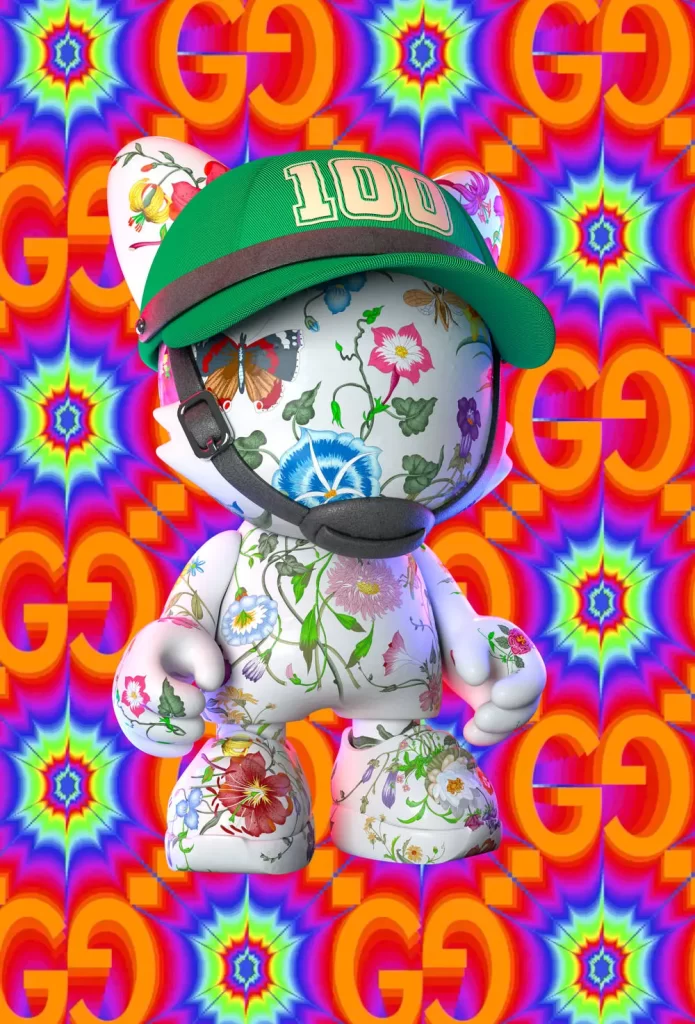NFT Trends in Luxury: Redefining Affluence with Creativity and Web3
Web3 is chic. There’s no other way to put it. It’s got buzz and it’s got glamour. Yet, below the surface, it’s doing a lot more to usher in a new era of ownership, engagement, and decentralized collaboration. The world it is directly impacting is fashion and luxury, though not in ways you might expect—it is shifting the sense of wealth, luxury, and how hierarchy (the means to access and exclusivity) works for consumers.
First, let’s get the facts out of the way. Currently, the global luxury market is estimated at a booming 1.5 trillion USD, with 8-10 % revenue growth in 2023 (source: Bain $ Company, 2023). The NFT market is expected to reach 3.2 billion USD by 2027, with the compound annual growth rate of 18.55% (Source: Statista, 2023). Combined, this Creative Economy sector is staggering. Therefore, to support this article, we turned to the hub of NFT and Luxury; Crypto Valley – or, to others known as… Switzerland. The professionals we interviewed all belong to the quickly growing professional group, Women In Web3 Switzerland.
We spoke with Emelie-Alice Fabrizi, Brand Strategist for Luxury Fashion based in Geneva. She is also the founder of The Good Token Society dedicated to promoting and supporting decentralized systems, blockchain, and token-based applications that have a positive impact on society. Fabrizi has a unique perspective, having transitioned from a fashion editor’s role in Paris to working with luxury watch companies in Switzerland. Fabrizi shared her insights, saying, “We all want to know where things come from. The Luxury industry today is focused on ethics; LVMH brands now provide the user a way to track their scarf and see the animals that have given you wool. You can follow exactly where products are made. For ESG, you don’t want to employ children, and thanks to the blockchain you can be sure (you are not). It’s more than marketing, it’s truly about building trust with your customer. It’s huge, and for the first time, thanks to the technology, brands can be believed.”
Zurich-based Janina Vinklere, a digital transformation strategist with Vividly, Ambassador for Exclusible, and recognized as one of the top one hundred women in tech by Women of the Future, emphasized the broader implications of NFTs. She noted, “NFTs are something we will see on most packaging for products (like Oreos, food and beverage, cosmetics and FMCG and others) and and Pudgy Penguins are leading the way already with their toys and NFT within the package in 2000 Walmart stores in US and hundreds of stores in UK. However, today, celebrities like Selena Gomez are interested in using NFTs to democratize access to their products. Luxury brands, including Cartier, are also focusing on leveraging NFTs. Aura, the luxury blockchain, operates as a consortium for luxury, functioning as a supply chain supply chain transparency, luxury item authenticity, transfer of ownership and resale, and personal relationship tool for LVMH brands. So, from top to bottom, this digital revolution is underway.”

A rendering from the Louis Vuitton digital Treasure Chest NFT collection – SOURCE
Trend 1: Decentralization and Trust in the Digital Age
Exclusivity, (or rather, “I can afford it but can’t”) once tied to unattainable price points, transforms this decentralized landscape. Scarcity remains a luxury hallmark, but innovations like fractional ownership and NFTs democratize access. These advancements expand luxury’s reach while maintaining an aura of exclusivity, redefining luxury as an inclusive, community-driven experience.
So, in the digital age, we find ourselves amid a profound shift in the luxury narrative. At its heart lies the fusion of decentralization and trust, powered by the incredible technology of Web3 – an ecosystem built on blockchain, smart contracts, and decentralized applications. Together, they are rewriting the rulebook for luxury, challenging its time-honored conventions – and, at times, snobbery.
Blockchain, with its transparent and unalterable ledger, has created a demand for trust in the luxury industry. Brands can now offer a meticulous record of their creations, addressing the ethical concerns of today’s consumers. The vague promises of authenticity are fading away, replaced by the ability to trace every step in the life of a luxury item, from the origin of raw materials to the final masterpiece.
But what about the idea of exclusivity? Exclusivity used to mean an elite world of privilege closed off to the lucky few. Now, with fractional ownership, multiple individuals can invest in a single luxury asset, whether it’s a masterpiece painting or a high-end watch. And then there are NFTs (Non-Fungible Tokens), offering a fresh dimension that allows ownership and trade of unique digital or physical assets. Luxury is no longer confined to solitary opulence; it’s become a communal experience, free from traditional confines.
Trend 2: The Rise of Direct Transactions and Digital Collectors

Courtesy Gucci
In the ever-evolving realm of NFTs, Web3 functions as an invisible hand that’s been quietly reshaping the landscape. It’s a world where direct transactions between creators and collectors are being strengthened, eliminating layers of intermediaries and ushering in a more transparent, efficient, and inclusive digital marketplace. Within the luxury and NFT sphere, this phenomenon means collectors now have an active hand in shaping the course of the digital art realm.
The simplicity of NFT ownership has been a game-changer, turning a click into ownership. It’s this simplicity that fueled the wildfire-like spread of this trend. When Art Market institutions like Sotheby’s recognized NFTs as valuable assets, it sent a ripple across the market, drawing in a new generation of collectors. Yet, this isn’t just a technological trend; it’s a cultural shift that reflects the evolving values of an entire generation.
This generation values experiences over physical possessions. The desire to minimize tangible belongings coexists with the need to flaunt digital affluence. The result? A new form of collecting, one that transcends the boundaries of the physical world and identifies affluence in novel ways.
Trend 3: NFT Sales by Luxury and Collectable Brands (Data from Statistica, 2022)
The NFT bull market of 2022 marked a significant pivot towards integrating digital innovation with traditional high-end fashion.
A notable example is the Italian fashion house Dolce & Gabbana, which embraced the hybrid physical/NFT model with its ‘Collezione Genesi.’ This pioneering collection, comprising nine exclusive pieces, garnered over $6 million, seamlessly blending the allure of physical items with the novelty of NFT versions, thus appealing to a discerning high-fashion clientele.
Similarly, RTFKT, recently acquired by Nike, has made a splash with its Fewo Sneakers, raking in upwards of $3 million. These unique sneakers extend their utility beyond the physical world, doubling as wearable items in the Decentraland metaverse – a testament to the blurring lines between digital and tangible luxury.
On the other hand, brands like Burberry have ventured into digital gaming platforms, offering exclusive items in games like ‘Blankos Block Party,’ showcasing a playful yet lucrative approach to NFTs.
However, the journey hasn’t been uniformly lucrative for all.
Prestigious brands such as Givenchy, Gucci, and Louis Vuitton ventured into the realm of NFTs through graphic designs, a fashion-centric movie, and a video game, respectively. Yet, these ventures garnered relatively modest returns, with Givenchy’s collection fetching around $159,000 and Gucci’s movie-themed NFT reaching about $25,000.
These figures illuminate an intriguing aspect of NFTs – their value proposition is rooted in the promise of exclusivity by the issuer. While the graphic designs, the movie, and the game are accessible online, the collectible NFTs linked to them, verified and recorded on the blockchain, are unique and issued only once by these illustrious houses, symbolizing a guarantee of exclusivity and potential value appreciation.
For clientele enamored with high fashion and collectibles, such as sneaker enthusiasts, the integration of practical applications both in physical and digital domains tied to NFT sales has been pivotal in swaying consumer interest. This trend demonstrates a strategic fusion of the allure of exclusivity with applied utility, revolutionizing how luxury and collectible brands engage with their discerning customers in a digitized age.
(Watch for PART 2 of this article series)

